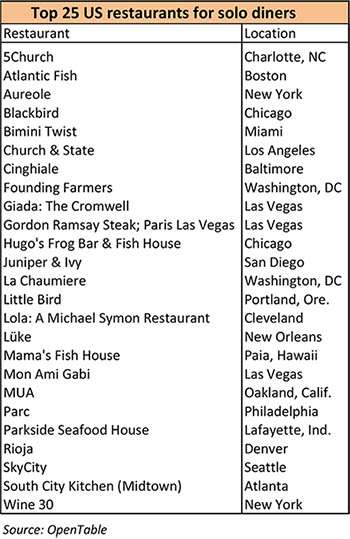Restaurant reservation site OpenTable crunched its numbers recently and came up with an interesting finding: The number of people going out to eat on their own has risen significantly in recent years, as evidenced by the number of party-of-one reservations made via OpenTable. Solo dining reservations have grown nationally by 62 percent in the past two years, making it the platform’s fastest-growing party size.
One likely contributor to this trend is the increase in single-person households—up from 17 percent of U.S. households in 1970 to 27 percent in 2012, according to the U.S. Census Bureau. But OpenTable says the uptick reveals that attitudes toward dining alone are also changing. “The stigma surrounding solo dining is lifting and…diners are eager to enjoy a unique dining experience on their own,” states the report.
OpenTable examined the data by metropolitan area and found that Dallas, Miami, Denver, New York, Philadelphia, Las Vegas and Chicago have experienced the strongest growth in reservations for one. The company drilled down further to discover which restaurants were most booked by solo diners. OpenTable’s “Top 25 Restaurants for Solo Diners in the U.S.” (see below) is based on which restaurants nabbed the most solo reservations, the “overall” star ratings from verified OpenTable users, and finally, the restaurant recommendations of the company’s experts.
 How to snag more solo reservations
How to snag more solo reservations
Of course, some of the increase in the number of reservations-for-one can be attributed to the popularity of the individual restaurants themselves. Many, including Aureole in New York, Blackbird in Chicago and Lola in Cleveland are among the best and most popular restaurants in their respective markets.
But among the restaurants that are doing well with single diners, other factors are at play as well.
“The restaurants we highlighted on this list are hosting impressive numbers of solo diners, and while they vary in cuisine, they excel at personalized, friendly table service that makes those dining alone feel very comfortable and embraced,” says Caroline Potter, chief dining officer at OpenTable. “You’re not going to hear, ‘Oh, is it just you?’ when you walk into these establishments.”
“[Managers] can work with staffers to make certain they are engaging guests of all party sizes,” Potter advises.
There are also physical measures restaurants can take to attract this growing demographic, including a variety of seating options, says Gregg Hackett, a Minneapolis-based architect. Hackett says bars, kitchen counters and, if space permits, counters overlooking windows are popular for singles. However, two-tops and other alternatives should also be offered to solo diners.
Restaurant designer Paul Basile of Basile Studio in San Diego agrees, adding that restaurants can incorporate “social seating” (communal tables work best at bar height, making the approach to the table less awkward) to allow guests make new friends and spark conversation. Designing pockets of dim lighting and brighter lighting for privacy or more exposure—depending on the individual diner’s mood—can also attract more singles.
Potter emphasizes that when it comes to seating options, operators should “offer up tables that round out the experience and allow diners to feel like they are connected to the dining room rather than being relegated to the bar or a table in a lonely corner. The emphasis should be on making the diner feel special—not solo.”
“As dining out has become one of our national pastimes, solo diners are taking every opportunity to visit top restaurants whenever they get the opportunity, much as they might attend a sporting event or show,” states the OpenTable the report. “Solo dining is about treating yourself to a delicious experience and savoring every bite…From communal and counter seating to doting table service, restaurants are welcoming parties of one with open arms.”
Contact Gina Ragone at [email protected]
Follow her on Twitter: @RagoneGina





